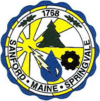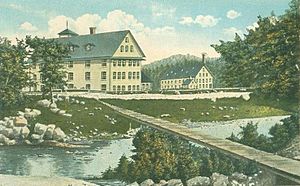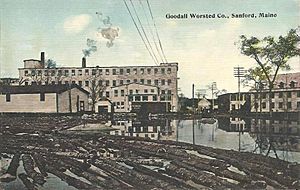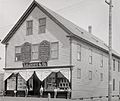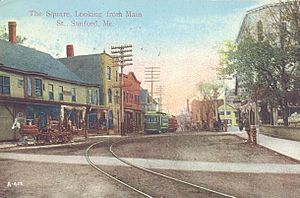Sanford, Maine facts for kids
Quick facts for kids
Sanford
|
||
|---|---|---|
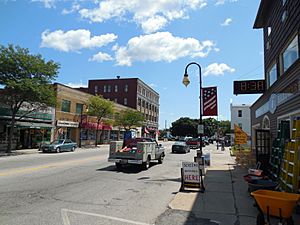
Sanford in 2014
|
||
|
||
| Nickname(s):
The heart of York County
|
||
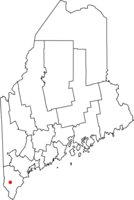
Location of city of Sanford in map of Maine
|
||
| Country | United States | |
| State | Maine | |
| County | York | |
| Settled | 1739 | |
| Incorporated | Town: February 27, 1768 City: January 1, 2013 | |
| Government | ||
| • Type | City Council/Mayor | |
| Area | ||
| • Total | 48.75 sq mi (126.27 km2) | |
| • Land | 47.79 sq mi (123.78 km2) | |
| • Water | 0.96 sq mi (2.50 km2) | |
| Elevation | 262 ft (80 m) | |
| Population
(2020)
|
||
| • Total | 21,982 | |
| • Density | 459.97/sq mi (177.59/km2) | |
| Time zone | UTC−5 (Eastern (EST)) | |
| • Summer (DST) | UTC−4 (EDT) | |
| ZIP Codes |
04073 and 04083
|
|
| Area code(s) | 207 | |
| FIPS code | 23-65760 | |
| GNIS feature ID | 0582712 | |
| Website | www.sanfordmaine.org | |
Sanford is a city in York County, Maine, United States. The population was 21,982 in the 2020 census, making it the seventh largest municipality in the state. Situated on the Mousam River, Sanford includes the village of Springvale. The city features many lakes in wooded areas which attract campers.
Sanford is part of the Portland-South Portland-Biddeford metropolitan area.
On November 6, 2012, Sanford voters approved a new charter to re-incorporate Sanford as a city and replace the town meeting format with a city council/mayor/strong manager form of government, along with other changes. The new charter took effect on January 1, 2013. Sanford's new charter provides that the first mayor would be appointed from the ranks of Sanford's seven city councilors and serve interim for one-year period. On January 8, 2013, Maura A. Herlihy was appointed as Sanford's first mayor.
In 2014, an elected-at-large mayor took office. On November 5, 2013, Thomas Cote was elected as mayor. Beginning in 2016, the mayoral position began being elected at-large every two years during legislative election cycles.
Contents
History
Sanford is in the western portion of a tract of land purchased in 1661 from Abenaki Chief Fluellin by Major William Phillips, an owner of mills in Saco. First called Phillipstown, it was willed in 1696 by Mrs. Phillips to her former husband's son, Peleg Sanford. Settlement was delayed, however, by hostilities during the French and Indian Wars. In 1724, Norridgewock, an enemy stronghold on the Kennebec River, was destroyed by a Massachusetts militia. Subsequently, the region became less dangerous, and Sanford was first settled in 1739. Incorporated a town in 1768, it was named after Peleg Sanford. Until 1794, Alfred was the town's North Parish.
The Mousam River provided water power for industry. In 1745, Capt. Market Morrison built a sawmill above Springvale. Following the Civil War, Sanford developed into a textile manufacturing center, connected to markets by the Portland and Rochester Railroad. Factories were built at both Springvale and Sanford villages. Products included cotton and woolen goods, carpets, shoes and lumber.
In 1867, British-born Thomas Goodall established the Goodall Mills at Sanford, after selling another mill in 1865 at Troy, New Hampshire which made woolen blankets contoured to fit horses. His factory beside the Mousam River first manufactured carriage robes and blankets. It would expand to make mohair plush for upholstering railroad seats, carpets, draperies, auto fabrics, military uniform fabric and Palm Beach fabric for summer suits.
The company's textiles were known for brilliant and fast colors, and found buyers worldwide. From 1880 to 1910, the mill town's population swelled from 2,700 to over 9,000, some living in houses built by the company and sold to workers at cost. In 1914, the Goodall family built Goodall Park, a 784-seat roofed stadium, now a treasured historic site. They also helped build the library, town hall, hospital, airport and golf club. A bronze statue was erected by the citizens of Sanford in 1917 to the memory of Thomas Goodall. His effigy has a place of honor in Central Park. George and Henrietta Goodall's daughter, Marion C. Goodall Marland, and her husband William Marland, continued the Goodall family philanthropy. A dormitory at Nasson College bears the Marland's name.
In 1954, Burlington Mills, then the nation's largest textile firm, bought Sanford Mills. After moving the looms to its Southern plants, Burlington closed Sanford Mills—leaving 3,600 unemployed and 2,000,000 square feet (190,000 m2) of empty mills. Local business owners began traveling the northeast, enticing new employers to move to the area. Life Magazine called Sanford "the town that refused to die." It now has diversified industries, including the manufacture of aircraft parts. When the federal government offered money in the 1960s for urban renewal to rehabilitate aging or blighted districts, more than thirty Sanford structures were razed. In Springvale, three of four corners were leveled. Nevertheless, much fine architecture from the town's prosperous mill era survived.
Sanford was the home of Belle Ashton Leavitt, the third woman attorney admitted to the Maine Bar Association. Leavitt was admitted to the Bar in 1900. Leavitt operated in partnership with attorney Fred J. Allen, her brother-in-law (Allen was married to Belle's sister Ida Leavitt), and member of the Maine Legislature.
In 2003, a proposal to build a $650 million casino in South Sanford was rejected by Maine voters. The 362-acre (1.46 km2) development, ostensibly owned by the Penobscot and Passamaquoddy nations, would have encompassed 4,000 slot machines, 180 gaming tables, a hotel, a 60,000-square-foot (5,600 m2) convention center and an 18-hole golf course. Proponents argued that it would add 4,700 permanent jobs and 25% of revenue would be directed to the state. Detractors predicted higher crime, traffic and an erosion of Maine's quality of life.
Geography
Sanford is located at 43°26′23″N 70°46′23″W / 43.43972°N 70.77306°W (43.439925, -70.773304). According to the United States Census Bureau, the city has a total area of 48.75 square miles (126.26 km2), of which, 47.78 square miles (123.75 km2) of it is land and 0.97 square miles (2.51 km2) is water. Located near foothills, Sanford is drained by the Mousam River. Mt. Hope, elevation 680 feet (207 m) above sea level, is the city's highest point. The lowest elevation, which is approximately 140 feet (42.7 m) above sea level, is on the Mousam River at Old Falls Pond as flows into Kennebunk.
Sanford borders the towns of Shapleigh, Acton, Alfred, Kennebunk, Wells, North Berwick, and Lebanon.
Demographics
- See also Sanford (CDP), Maine, South Sanford, Maine, and Springvale, Maine for village demographics.
| Historical population | |||
|---|---|---|---|
| Census | Pop. | %± | |
| 1790 | 1,799 | — | |
| 1800 | 1,363 | −24.2% | |
| 1810 | 1,492 | 9.5% | |
| 1820 | 1,831 | 22.7% | |
| 1830 | 2,327 | 27.1% | |
| 1840 | 2,233 | −4.0% | |
| 1850 | 2,330 | 4.3% | |
| 1860 | 2,221 | −4.7% | |
| 1870 | 2,397 | 7.9% | |
| 1880 | 2,734 | 14.1% | |
| 1890 | 4,201 | 53.7% | |
| 1900 | 6,078 | 44.7% | |
| 1910 | 9,049 | 48.9% | |
| 1920 | 10,691 | 18.1% | |
| 1930 | 13,392 | 25.3% | |
| 1940 | 14,886 | 11.2% | |
| 1950 | 15,177 | 2.0% | |
| 1960 | 14,962 | −1.4% | |
| 1970 | 15,812 | 5.7% | |
| 1980 | 18,020 | 14.0% | |
| 1990 | 20,463 | 13.6% | |
| 2000 | 20,806 | 1.7% | |
| 2010 | 20,798 | 0.0% | |
| 2020 | 21,982 | 5.7% | |
| 2022 (est.) | 22,266 | 7.1% | |
2010 census
As of the census of 2010, 20,798 people, 8,500 households, and 5,417 families resided in the city. The population density was 435.3 inhabitants per square mile (168.1/km2). There were 9,452 housing units at an average density of 197.8 per square mile (76.4/km2). The city's racial makeup was 94.7% White, 0.6% African American, 0.4% Native American, 2.0% Asian, 0.3% from other races, and 2.0% from two or more races. Hispanic or Latino of any race made up 1.6% of the population.
There were 8,500 households, of which 30.6% had children under the age of 18 living with them, 44.7% were married couples living together, 13.1% had a female householder with no husband present, 5.9% had a male householder with no wife present, and 36.3% were non-families. 28.9% of all households were made up of individuals, and 11.2% had someone living alone who was 65 years of age or older. The average household size was 2.41 and the average family size was 2.91.
The median age in the city was 40.5 years. 22.6% of residents were under the age of 18; 8.2% were between the ages of 18 and 24; 25% were from 25 to 44; 29% were from 45 to 64, and 15.1% were 65 years of age or older. The gender makeup of the city was 47.9% male and 52.1% female.
Fire department
Sanford citizens are protected by Firefighter/EMT's working out of three fire stations located in Springvale, South Sanford, and Downtown Sanford. 3 Engines, 1 Ladder, and 1 Rescue are staffed 24 hours a day; 365 days a year. Authorized strength is 45 full-time fire personnel. SFD also provides Emergency Medical Services. All firefighters are required to have a Maine EMS license ranging from EMT-Basic to Paramedic. In 2007 SFD responded to 1,150 Fire Runs & 2,515 Medical Runs for a total of 3,665 emergencies.
School system
In 2018, Hutter Construction Co. workers built a new high school on a 127-acre campus in the center of town. The construction cost was billed at $103 million, with the state covering the majority of the cost. It is a career-focused school, separated into four wings, in which students select specialized courses geared towards their preferred future career.
Sites of interest
- Louis B. Goodall Memorial Library
- Springvale Public Library
- Sanford-Springvale Historical Society & Museum
- Goodall Park - Baseball stadium home to the Sanford Mainers, two-time champions of the New England Collegiate Baseball League
- Mousam River
Events
- Sanford International Film Festival—an annual event that specializes in independent film
Notable people
- Frank Augustus Allen, mayor of Cambridge, Massachusetts (1877)
- Randy Brooks, musician
- Michael Richard Cote, Bishop of Norwich, Connecticut
- Nick Curran, musician
- Vic Firth, musician, businessman
- Ann Fredericks, state legislator
- Louis B. Goodall, businessman, U.S. congressman
- Rachel Griffin-Accurso, better known as Ms. Rachel, American YouTuber, social media personality, songwriter, and educator, raised in Sanford
- Jane Lord Hersom (1840–1928), physician, suffragist
- Sumner Increase Kimball, organizer of the United States Life-Saving Service, founder of Coast Guard Academy
- Peter Kostis, golf instructor, sportscaster
- Raymond Luc Levasseur, member of the United Freedom Front
- Franz Lidz, journalist and author of the memoir Unstrung Heroes
- Mike McGinnis, composer, musician
- Patrick James McGinnis, investor, author
- Freddy Parent, Major League Baseball shortstop (1899–1911)
- Lawrence Lee Pelletier, 16th president of Allegheny College
- Amédée Wilfrid Proulx, Catholic bishop
- Joe Riggs, mixed martial arts fighter, UFC veteran
- Rachel Schneider Olympic Runner
- Charles A. Shaw, 19th-century politician, inventor
- John Storer, the namesake of Storer College
- John Tuttle, Maine state legislator
See also
 In Spanish: Sanford (Maine) para niños
In Spanish: Sanford (Maine) para niños


